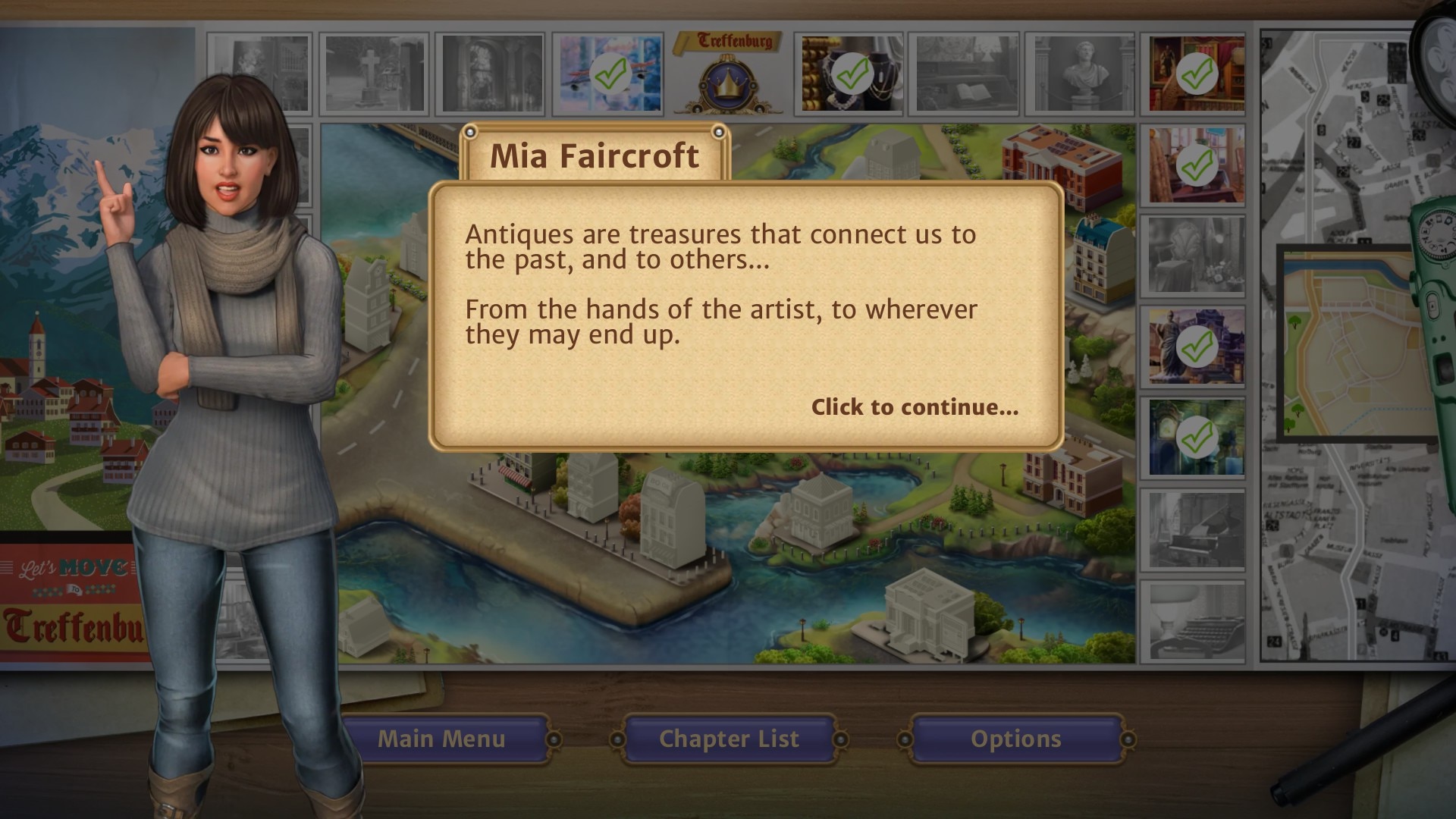
Faircroft’s Antiques: Treasures of Treffenburg
Faircroft’s Antiques: Treasures of Treffenburg is the first of five installments in the Faircroft’s Antiques hidden object games series and constitutes a very good introduction to what the franchise is about.
Intro

The games follow the adventures of Mia Faircroft – a young art restorer who travels all around the world and helps people refurbish their antiques, but also mends their hearts with her positive and kind personality. In Faircroft’s Antiques: Treasures of Treffenburg she arrives in the Austrian town of Treffenburg, where she starts investigating the history of Lady Ophelia Harcourt – a 19th century personality whose family established a big part of the town’s current buildings and left behind a considerable amount of valuable antiquities.

Gameplay
Faircroft’s Antiques: Treasures of Treffenburg is an old-style HOG that focuses more on hidden object scenes and minigames and less on the adventure aspect, which is basically almost non-existent here. Instead, the sheer amount of conversations between the characters and their identity development could indeed place the Faircroft games at the border between a HOG and a visual novel.

There is a good variety of hidden object scenes, consisting of identifying objects based on a list of items, their image, on their silhouette or simply by solving a mini-riddle. The game has 20 chapters in total, each of them inviting the player to solve around four different hidden object scenes and a couple of minigames. Several dialogue lines are presented before and after every scene and they are designed in such a way that the locations can be visited in any order without spoiling the story or having these conversations affected in any way.

Story
In regards to the story, the games can be played independently of each other, but being the first one in the series, Faircroft’s Antiques: Treasures of Treffenburg will introduce some recurring characters that will also appear in the subsequent games. However, the plot lines of the five installments do not have any other connections with each other apart from sharing these common characters and can be experienced as standalone games.

Also, being the first game and presumably a first try at the franchise, the story turns out to be less coherent than in the other games, namely that it is presented in a more episodic manner. Each chapter introduces a new heirloom to fix, and with that a new detail about Lady Ophelia Harcourt’s private life is revealed, while in the other games each character has a specific plot line to follow, and that plot line is slowly developed from the beginning to the end of the game.

Graphics
All the locations are beautifully drawn and decorated with small animations that heavily contribute to a cozy atmosphere: you can see snow falling outside the windows, people passing by on the streets, phones turning on and off when receiving a message and many other small details that add a really nice touch to each scene. The objects to find seem to be randomly generated, and they appear slightly on top of the background (they don’t fully blend), which makes them stand out a little bit but this way they’re easier to find. This is by no means something bothersome, and it doesn’t look “cheap” or “glued on”, but it does break the immersion a tiny bit. On the other hand, the color palette is consistent and harmonious throughout the game and even if some of the objects don’t seem to fit in the context of the scene (which is a given with all the HOGs), they’re placed in rather intuitive locations on the screen, somewhere where you would expect them to be.

Characteristics
One characteristic of the Faircroft’s Antiques games that I particularly like is the scene arrangement. The locations are presented in a Monopoly-board-like manner with a map of the city in the center and the 20 different scenes displayed around its outside border, linked to buildings that are highlighted on the map when mousovering their corresponding location. The ones that you can’t visit in a chapter are grayed out, while the active ones also indicate whether you have to solve a hidden object scene or a minigame. You can therefore choose which of the locations you want to visit first, namely which storylines you want to explore first. Mia also tells the player at the beginning of the chapter what goals she needs to pursue and which locations correspond to each of these goals.

Conclusion
Faircroft’s Antiques games are a must-buy for HOG lovers, especially since they cost close to half of an Artifex Mundi game and offer twice (or in some cases even three times) the playtime and depending on the case and on your taste, a more entertaining and well-crafted story. Faircroft’s Antiques: Treasures of Treffenburg sadly does not offer any Steam achievements, and there are no plans on adding some in the future, therefore if you’re looking for a game to play that also rewards some easy achievements, then Faircroft’s Antiques: The Forbidden Crypt is the one to go to.